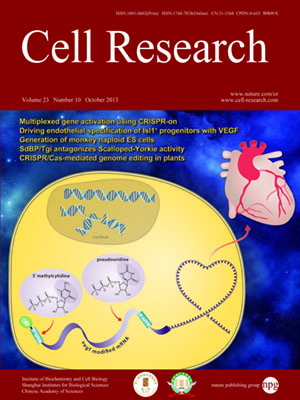
Volume 23, No 10, Oct 2013
ISSN: 1001-0602
EISSN: 1748-7838 2018
impact factor 17.848*
(Clarivate Analytics, 2019)
Volume 23 Issue 10, October 2013: 1172-1186
ORIGINAL ARTICLES
Driving vascular endothelial cell fate of human multipotent Isl1+ heart progenitors with VEGF modified mRNA
Kathy O Lui1,2,3,*, Lior Zangi1,2,4,*, Eduardo A Silva5,6, Lei Bu1,2,3, Makoto Sahara1,2, Ronald A Li3,7, David J Mooney5 and Kenneth R Chien1,2,8
1Cardiovascular Research Center, Massachusetts General Hospital, Boston, MA 02114, USA
2Department of Stem Cell and Regenerative Biology, Harvard University, Cambridge, MA 01238, USA
3Stem Cell and Regenerative Medicine Consortium, LKS Faculty of Medicine, University of Hong Kong, Pokfulam, Hong Kong SAR, China
4Department of Cardiology, Children's Hospital, Boston, MA 02115, USA
5School of Engineering and Applied Sciences, Harvard University, Cambridge, MA 02138, USA
6Department of Biomedical Engineering, University of California, Davis, CA 95616, USA
7Cardiovascular Research Center, Mount Sinai School of Medicine, New York, NY 10029, USA
8Department of Cell and Molecular Biology, Karolinska Institute, SE-171 77 Stockholm, Sweden
Correspondence: Kathy O Lui, E-mail: kathyolui@fas.harvard.edu; Kenneth R Chien,(kenneth.chien@ki.se)
Distinct families of multipotent heart progenitors play a central role in the generation of diverse cardiac, smooth muscle and endothelial cell lineages during mammalian cardiogenesis. The identification of precise paracrine signals that drive the cell-fate decision of these multipotent progenitors, and the development of novel approaches to deliver these signals in vivo, are critical steps towards unlocking their regenerative therapeutic potential. Herein, we have identified a family of human cardiac endothelial intermediates located in outflow tract of the early human fetal hearts (OFT-ECs), characterized by coexpression of Isl1 and CD144/vWF. By comparing angiocrine factors expressed by the human OFT-ECs and non-cardiac ECs, vascular endothelial growth factor (VEGF)-A was identified as the most abundantly expressed factor, and clonal assays documented its ability to drive endothelial specification of human embryonic stem cell (ESC)-derived Isl1+ progenitors in a VEGF receptor-dependent manner. Human Isl1-ECs (endothelial cells differentiated from hESC-derived ISL1+ progenitors) resemble OFT-ECs in terms of expression of the cardiac endothelial progenitor- and endocardial cell-specific genes, confirming their organ specificity. To determine whether VEGF-A might serve as an in vivo cell-fate switch for human ESC-derived Isl1-ECs, we established a novel approach using chemically modified mRNA as a platform for transient, yet highly efficient expression of paracrine factors in cardiovascular progenitors. Overexpression of VEGF-A promotes not only the endothelial specification but also engraftment, proliferation and survival (reduced apoptosis) of the human Isl1+ progenitors in vivo. The large-scale derivation of cardiac-specific human Isl1-ECs from human pluripotent stem cells, coupled with the ability to drive endothelial specification, engraftment, and survival following transplantation, suggest a novel strategy for vascular regeneration in the heart.
10.1038/cr.2013.112
FULL TEXT | PDF
Browse 2507


